Every winter hundreds of Bald Eagles migrate south from Canada and Alaska and winter in Utah. They do so because of our relatively mild winters and they are able to find sufficient food here. Typically they begin arriving in November and leave in March when the ice begins to melt. They can be found in many areas of the state but a large percentage of them winter on the wetlands surrounding the Great Salt Lake where there are a number of bird refuges and other suitable areas to accommodate them.
 Adult Bald Eagle in flight
Adult Bald Eagle in flight
Each year I spend many hours at some of the Great Salt Lake wetlands photographing eagles. What attracts them to some of the refuges is fish – lots of fish, especially carp. Carp are a nuissance for wildlife managers because they root in the mud of the shallow impoundments which makes the water cloudy and unable to transmit light to the bottom. This disrupts the healthy growth of desirable plant species needed by birds so some refuges “poison” the carp, usually in mid-winter, with rotenone – a non-toxic chemical that forms a film on fish gills preventing oxygen transfer from the water to the blood which kills the carp. Then it’s feast time for the eagles.
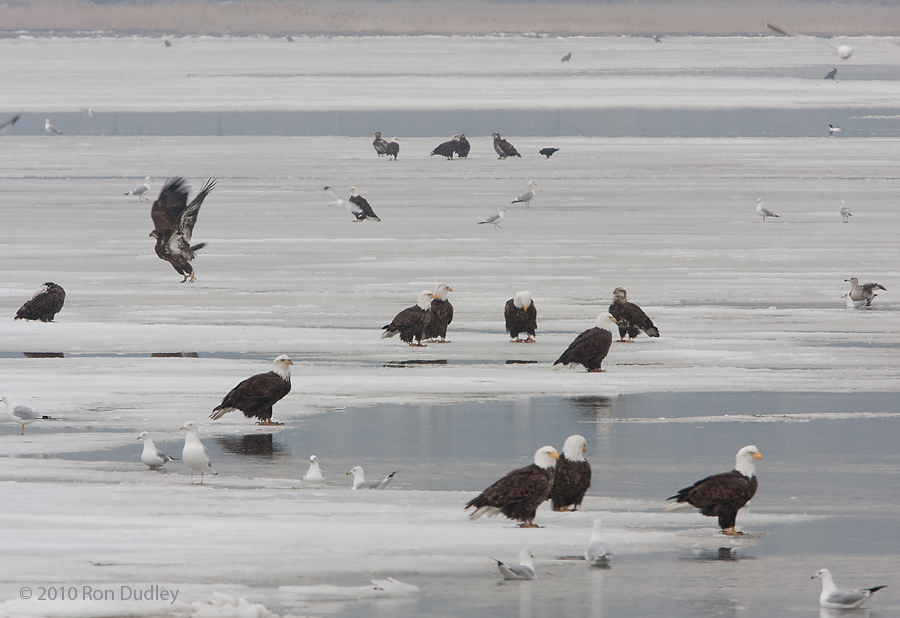
Bald Eagles and gulls on the ice
It’s common to see several hundred Bald Eagles from one spot. One refuge counted 408 eagles. I’ve personally seen 150 – 200 birds on several occasions.

Immature Bald Eagle with carp
This is why they’re here – fish! Specifically, carp. Lots of carp are killed, many of them are very large, and the freezing water keeps the fish in relatively good condition for a long time. So, there’s plenty of food for lots of eagles for many weeks. As you can see, they often pick the carp carcasses clean.
A word of explanation here. Many folks believe that all Bald Eagles have the well-known white head and tail. That’s true only of the adults. Immature birds, up to about their fifth year when they become sexually mature, are dark brown with varying amounts of white in their plumage but they lack the all white head and tail.
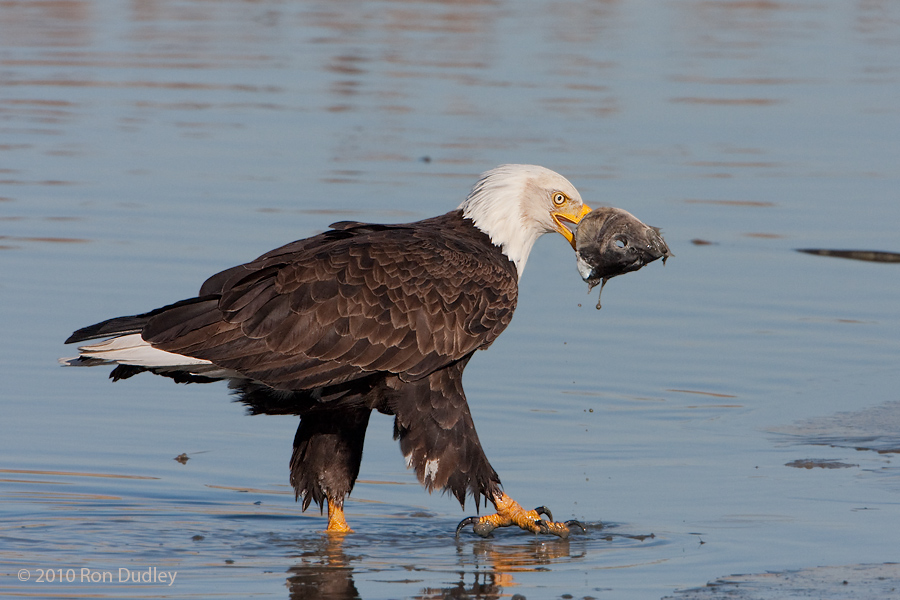
Adult Bald Eagle with carp head
Many years, most of the water is frozen and the only open water is at ponds with moving water which keeps it from freezing so the eagles often concentrate at such places. The photo above was taken at one of those ponds and you can see some of the ice to the right in the frame.

Adult threatening a sub-adult over food
Bald Eagles seem to be pugnacious by nature and that tendency is aggravated when so many birds are in close proximity and competing for food. Squabbles, threats, intimidation displays and outright fights are relatively common though I’ve never seen an eagle injured in such encounters.
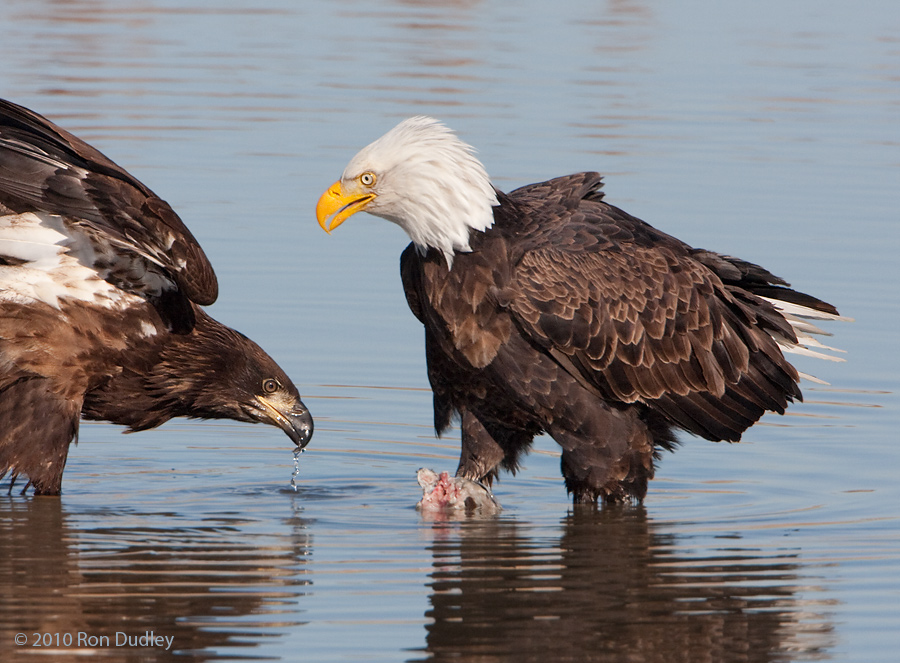
A fight waiting to happen
While I was watching this immature bird attempting to steal the adults fish I was sure a fight was about to break out. It didn’t, but it was close. The juvenile ended up plucking up a small piece of fish from the water just under its beak and then beat a hasty retreat. No excitement this time.
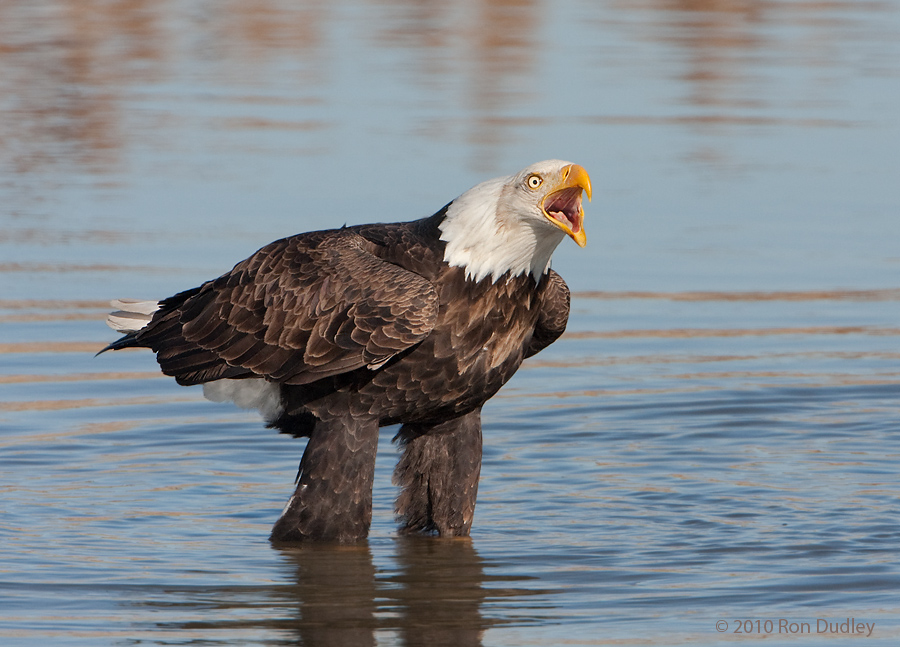
Adult screaming a threat
Sometimes an eagle would approach another feeding bird and scream threats at it which is what’s happening in the photo above. It usually didn’t work. The other eagle is just out of frame to the right. I love the “pantaloons” on these birds!
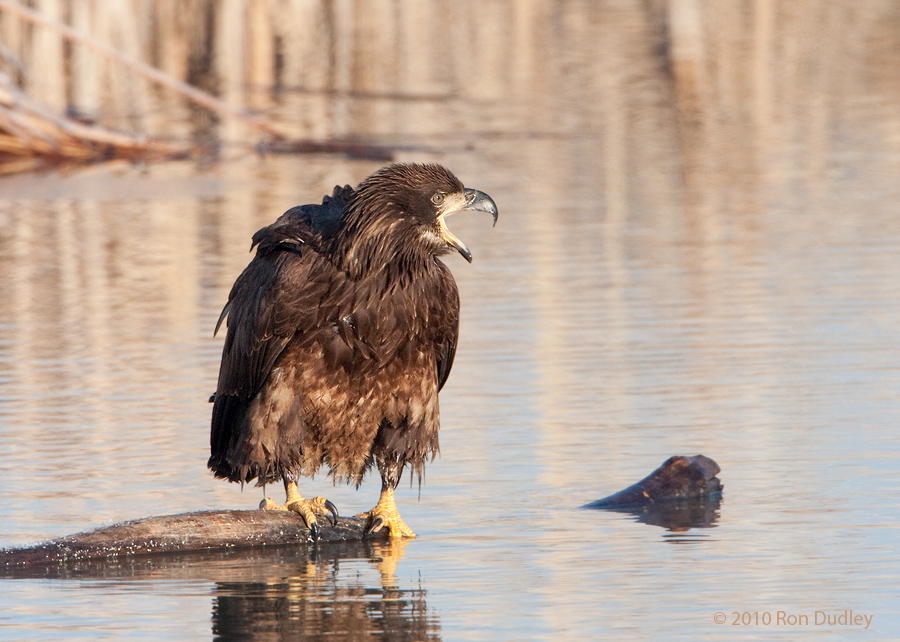
Juvenile complaining after it had been repelled by an adult
This juvenile lost an altercation with an adult over a fish, retreated to this perch, and voiced its disapproval. Loudly!
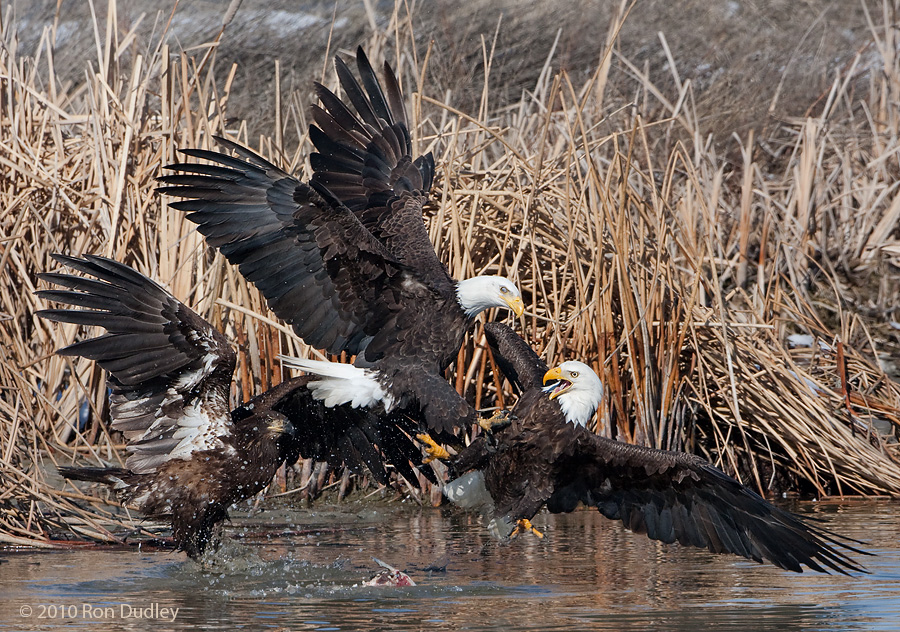
Two adults and a juvenile Bald Eagle fighting over a fish
When fights do break out it’s a challenge for the photographer. You’re set up to try to get close to them for good detail and then those huge wings go flailing in every unexpected direction. It’s very difficult to get all the action in the frame when that happens without cutting off or clipping something, wings especially. They’re very serious in this behavior as you can tell by the talon action.
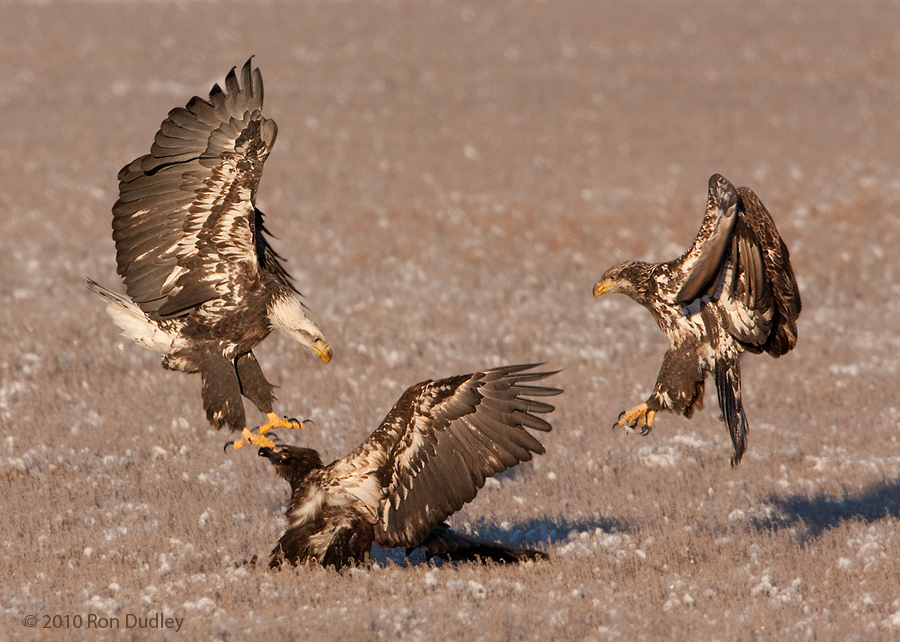
Bald Eagles fighting over a duck
This shot was taken in early December, before the fish kill and when food is at a premium so the eagles take what they can get. In this case, one of them had killed a duck (possibly a coot) and carried it out to an open meadow to enjoy its meal in peace. No such luck! Within minutes three other eagles and a raven came in to challenge it for the meal (one eagle and the raven are out of frame and the duck is under the eagle on the ground).
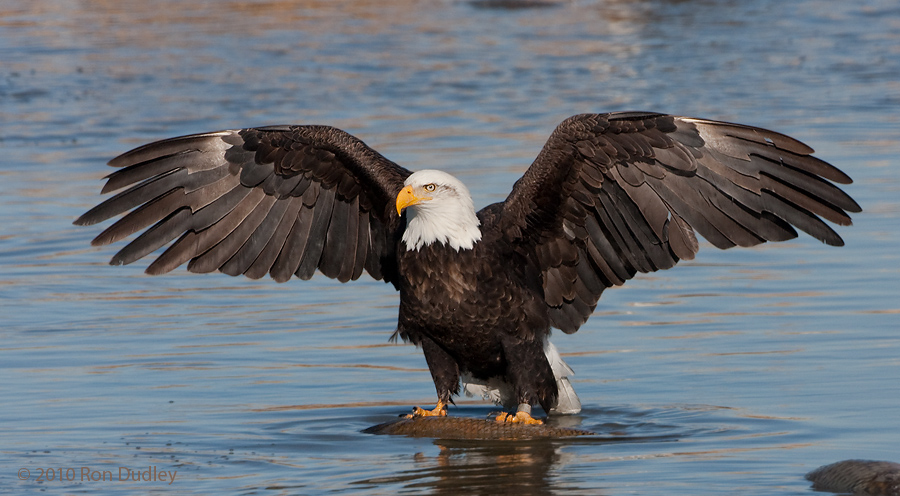
Protecting the fish
Here is a behavior I hadn’t seen before. This bird had just landed on this nice, fresh carp that hadn’t been picked on at all by other birds. The eagle kept its wings spread out like this for quite a while. My interpretation of the behavior is that it was telling the other eagles close by, maybe a half dozen of them, that “this is mine and I’m too big for you to take it away so don’t even try”. My interpretation of what I saw – maybe I’m right and maybe I’m not…

Approaching the feast, and a confrontation
Time after time eagles would come in to land where there were both fish and other eagles in possession of them. They always seemed to have this very serious and determined look about them as if they were anticipating the confrontation that was likely to unfold. Anthropomorphic of me, I’m sure…
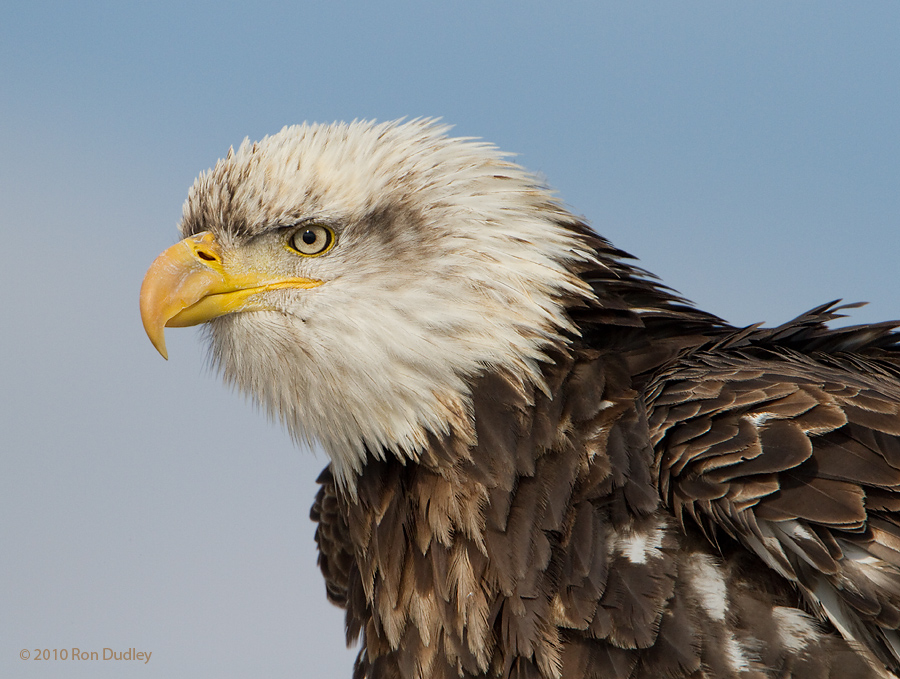
Bald Eagle portrait
One eagle seemed particularly tolerant of my truck (I nearly always shoot from my vehicle). This bird would hunt live fish on its own and then return to the same pole perch to eat. I would park right next to the pole and wait for it to return, sometimes with a fish. It had no hesitation in landing on the pole which amazed me. Here, it had just finished eating and I decided to go for a closeup.
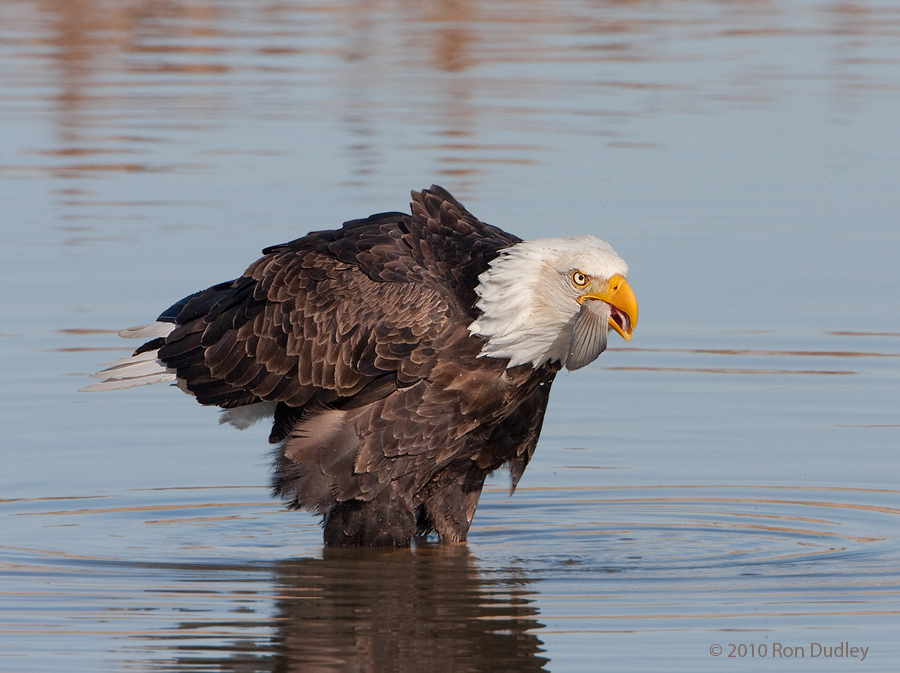
Even the fins taste good
Ok, the end of the tale and of this birds meal. The eagles of the Great Salt Lake are a blast to photograph every winter and I hope this winter is a good one, for both me and the eagles.
I want to mention that some photographers (with differing field ethics from mine) have been known to move dead carp to more “photogenic” spots. When you arrive you never know if it’s happened or not. Some of the fish in a couple of these shots may have been moved (baiting) – I doubt it but I just don’t know for sure.
This post is a bit of an experiment. The image file sizes are larger than in the past and there’s more of them so I’m a bit worried that some may find it irritatingly slow to load this blog. I’d appreciate knowing your experience with it, either way.
Ron


I love watching the eagles in there nest. The eagles is my favorite bird.I watched them last year hatch each egg. I watched them until each little eagle started flying and leave the nest. I have been watching them this year too.
Titan Fantasy – Thank you so much! That you found it appropriate to associate that particular quote with my blog means a lot to me.
I like this website so much, saved to fav. “Respect for the fragility and importance of an individual life is still the mark of an educated man.” by Norman Cousins.
Thanks Richard.
My birding lens is the Canon 500mm f/4L IS, typically used with a 1.4 teleconverter. No, I wasn’t out there yesterday for just the reason you mention – poor light.
Ron,
Yesterday I just made my first trip.. if you were there then you know the sky was not agreeable. I am extremely happy with what I got.. but these are AMAZING! I’m impressed, for sure.
Question: what lens were you using? Definitely has more reach than my 70-300 (on a 1.6 crop). I was envious of almost everyone’s lenses there.
I look forward to seeing more!
-Richard
New to Utah, and have just developed an interest in photography.
Having arrived in Northern Utah in September, I am very interested in trying to get a few personal shots of eagles, but have no clue where the best opportunities are.
Looking for some advice, and this certainly seems a great start!
Ron-no problem with the file size for me, loaded up quickly. As I’ve been following your blog I’ve come to expect two things; 1) Outstanding photography,and 2) An informative and exciting lesson on avian behavior.
Simply outstanding work. Congratulations, and thanks for your efforts!
Best,
Chuck Gangas
Ron, I was over looking at Rich Ditch’s blog and stumbled upon your blog. Just some stunning bald eagle shots, amazing display of behavior in these shots. I am glad you posted the images in the size you did, the focus and sharpness of the images is right on. Excellent images, a real treat to find your postings, thanks for sharing these images.
Regards,
Jim Hackley
Tucson, AZ